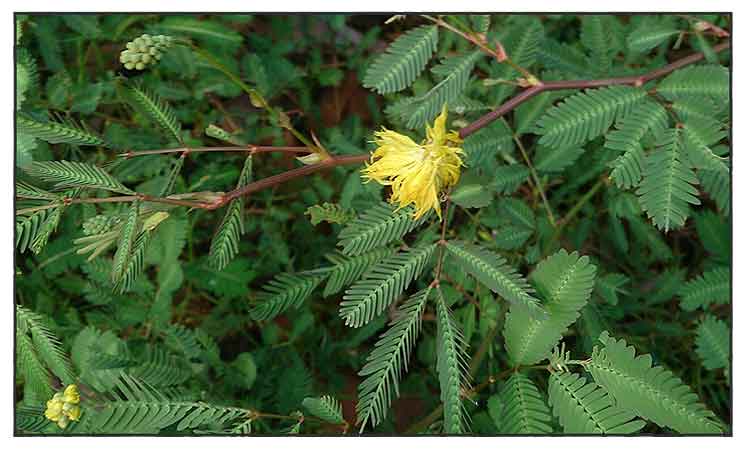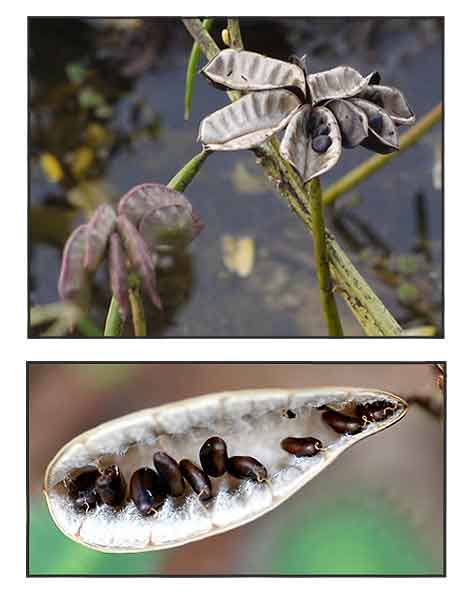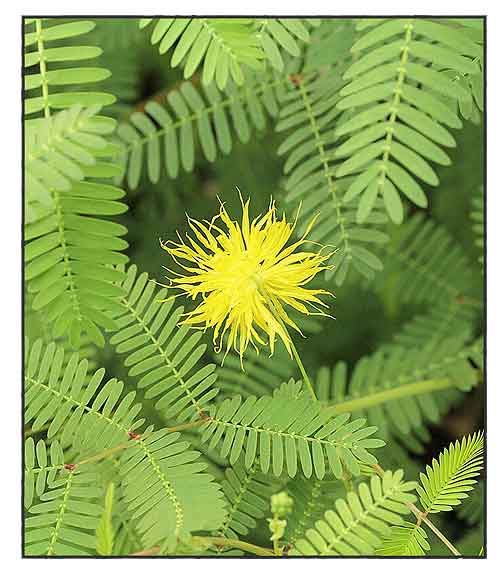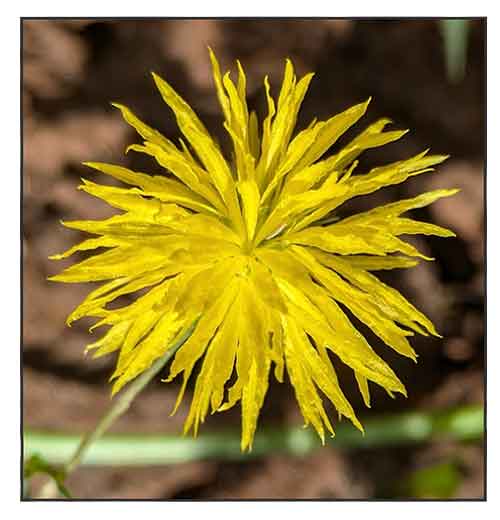 Gen info Gen info
- Neptunia is a genus of flowering plants in the family Fabaceae. It belongs to the mimosoid clade of the subfamily Caesalpinioideae. (6)
- Neptunia is a pantropical genus of 11 to 12 species. The genus is split into two sections: Neptunia and Pentanthera. Neptunia oleracea and N. plena belong to section Neptunia. These two species are the only aquatic or semi-aquatic species in the genus. (21)
-
Neptunia oleracea is a species of flowering plant in the legume family, Fabaceae. It is a pantropical nitrogen-fixing perennial legume.
- Etymology: The genus and common name neptunia derives from Neptune, god of the sea, referring to the aquatic habit of some species in the genus. The specific epithet oleracea derives from Latin holeraceus, meaning "vegetable / herbal". (5) The genus name Neptunia means "of the seas", referring to Neptunus, the Greek god of the seas. Oleracea means "of cultivation, aromatic, esculent, vegetable".
 Botany Botany
• Neptunia oleracea is an herbaceous, perennial plant, prostrate, spread out on the ground or floating on water. The stem is tinged with purple. The leaves are alternate, petiolate, compound bipinnate, sensitive to the touch. Each leaflet is itself compound paripinnate, comprising of 6 to 20 pairs of oblong leaflets, glaucous green in color. The rachis and the base of the leaflets  are of a light green color forming a broad, light green line in the center of the leaflet. This is a characteristic feature of this species. At the base of the petiole are two stipules with an asymmetrical cordate base. The inflorescence is axillary, extensively pedunculate forming a globular yellow head. Fruits are flattened pods, arranged at the end of the peduncle and spread out perpendicularly.
• Growth form: A perennial aquatic herb that is sometimes grown as an annual, it can grow as a floating plant or prostrate near the water’s edge. In its rooted land form, the plant has smaller leaves and flowers, with no spongy floating tissue. Roots: A thick taproot that becomes woody. Foliage: Leaves green, alternate and bipinnate with petioles 2-7 cm long. Stems: Stems terete (= like a slender, tapering cylinder, more or less circular in any cross-section), growing up to 1.5 m long and rarely branched. They become detached from the primary root system, with spongy-fibrous tissue (for floating) and fibrous adventitious roots forming at the internodes, when growing in water. Flowers: Inflorescence a solitary axillary spike (= inflorescence with sessile flowers) that may be erect or slightly nodding, the peduncle (= the stalk of the inflorescence). Flowers are small and sessile (= not stalked), sterile ones on the lower part of the inflorescence and bisexual ones on the upper part. Calyx bell-shaped and corolla consisting of five free yellow petals. Fruit: A legume, green when unripe and brown when mature, splitting along both sides and contains 4-8 seeds that are brown in color. (Flora & Fauna Web)
 Distribution Distribution
- Native to the Philippines. (1) (2)
- In Mindanao: Agusan del Norte, Agusan del Sur.
In shallow lakes and swamps; 0-200 m. (2)
- Also native to
Andaman Is., Assam, Bangladesh, Benin, Bolivia, Borneo, Botswana, Brazil North, Brazil Northeast, Brazil West-Central, Burkina, Burundi, Cambodia, Cameroon, Central African Republic, Chad, Colombia, Congo, Costa Rica, Cuba, Dominican Republic, DR Congo, East Himalaya, Ethiopia, Gambia, Ghana, Guatemala, Guinea, Guinea-Bissau, Honduras, India, Ivory Coast, Jamaica, Jawa, Kenya, KwaZulu-Natal, Laccadive Is., Laos, Lesser Sunda Is., Madagascar, Malawi, Malaya, Maldives, Mali, Maluku, Mauritania, Mexico Gulf, Mexico Northwest, Mexico Southeast, Mexico Southwest, Mozambique, Myanmar, Namibia, Nepal, Nicaragua, Nicobar Is., Niger, Nigeria, Northern Provinces, Panamá, Peru, Puerto Rico, Senegal, Sierra Leone, Somalia, Sri Lanka, Sudan-South Sudan, Sulawesi, Sumatera, Tanzania, Thailand, Togo, Uganda, Venezuela, Vietnam, West Himalaya, Zambia, Zimbabwe (1)
Constituents
- Proximate nutrient analysis of aqueous leaf extract revealed high fiber 52%, moisture 23.33%, fat 5.33%, protein 5.25%. carbohydrate 6.42%, ash 7.67%, and mineral content with Potassium > Calcium > Sodium > Phosphorus. Total phenolic content (TPC) and total flavonoid content (TFC) were 136.19 mg GAE/g and 829.17 mg GAE/g of dry weight, respectively. (8)
- Phytochemical screening of ethanol and aqueous extracts of leaves yielded flavonoids, triterpenoids, and tannins. (see study below) (15)
- Thin Layer Chromatography (TLC) of leaves and roots revealed polar compounds and phytochemical screening revealed flavonoids in leaves and roots, while tannins and alkaloids were found only in the leaves. (see study below) (17)
Properties
- Studies have suggested anticancer, antioxidant, phytoremediative, antimicrobial, antidiabetic, antimalarial properties.
Parts used
- Roots, stems, leaves.
 Uses Uses
Edibility
- Grown and used as vegetable, especially in Thailand and Vietnam. (4)
- In Thailand, where it is a common ingredient of Thai cuisine, cultivated for the young shoots, which are eaten raw, cooked, or fried. (12)
- Floating leaves and stems are edible, raw or cooked. Crispy and juicy, used in salads, cooked as potherb and used in sour vegetable salads. Young seed pods are edible, cooked.
(18)
Folkloric
- In the Philippines, (2)
- Used for treatment of fevers, earaches, dysentery, tumors, and syphilis.
- Used for treatment of epileptic convulsions, jaundice, bloody diarrhea.
- In Malaysia, roots and stem juice used for treatment of earaches, syphilis, and necrosis of the bones of the nose. (12) In Kelantan, Malaysia, roots are used as external remedy for necrosis of the nose and hard palate. Juice of stem squeezed into the ear for earache. Roots used for advanced stages of syphilis. In Nigeria, used for the treatment of yellow fever and Guinea worm infection. (21)
Others
- Fodder: In Madagascar, young plants are used as fodder for animals. (4)
Studies
• Anticancer: Study evaluated the anticancer activity of methanolic extract of N. oleracea. Antiproliferative activity was studied on hematological cancer cell lines using cell cycle analysis and apoptosis assays. The extract induced cell death in cancer cells while sparing normal cells. There was increase in cleaved PARP and reduction in BCL-2 levels and reduction in c-Myc and pERK1/2 protein levels. The results highlight the potential of N. oleracea as a promising anticancer agent. (7)
• Antioxidant / Nutrient Analysis / Leaves: Study evaluated phytoconstituents, TPC, TFC. and antioxidant properties of aqueous leaf extract. Hydrogen peroxide scavenging activity showed IC50 of 70.09 µg/mL. The high content of polyphenolic compounds may reflect on the antioxidant properties of the plant. (see constituents above) (8)
• Effect on Intestinal Motility / Toxicological Study: Preliminary qualitative phytochemical screening of aqueous and hydroethanolic extracts of N. oleracea yielded similar constituents including steroids, triterpenoids, saponins, tannins, flavonoids, anthocyanidins, cou8marins, and carbohydrates, with absence of alkaloids in both extracts. Acute toxicity study showed LD50 of 5000 mg/kg for both extracts, indicating no toxic effect. On evaluation of effect on intestinal peristalsis in mice, the aqueous and hydro-ethanolic extracts stimulated normal intestinal transit by 1.209 and 8.5% respectively at dose of 50 mg/kbw. The extracts potentiated acetylcholine-induced intestinal transit by 23.9 and 14.39% respectively at 500 mg/kbw. (9)
• Metabolite Variations with Drying Methods / Leaf and Stem: Study evaluated metabolite variations of leaf and stem subjected to air drying (AD), freeze drying (FD), and over drying (OD) using proton nuclear magnetic resonance based metabolomics. A total of 10 metabolites were identified, including 10 primary metabolites, 5 flavonoids, and 3 phenolic acids. Multivariate data analysis showed strong correlation between metabolites with the antioxidant and α-glucosidase inhibitory activities of FD leaves. Compounds suggested to be responsible for high activity of FD leaves include vitexin-2-O-rhamnoside, catechin, caffeic acid, gallic acid, and derivatives of quercetin, kaempferol, and myricetin. Study demonstrates freeze-dried leaves are a potential natural source for antioxidant and α-glucosidase inhibitors. (10)
• Antioxidants and α-Glucosidase Inhibitors: Study focused on identification of bioactive compounds from different polarity fractions of N. oleracea, namely hexane, chlorform, ethyl acetate, and methanol. Analysis revealed strong correlation between phenolics and bioactives of the ethyl acetate and methanol fractions. Findings support N. oleracea as a rich source of phenolics with potential as antioxidants and
α-glucosidase inhibitors for the management of diabetes. (11)
• Phytoremediation of Arsenic-Polluted Water: Arsenic is a toxic and heavy metal that exists in drinki9ng water and can lead to acute biotoxicity. Water mimosa has been widely identified as a feasible phytoremediator to clean up aquatic systems. Study evaluated the phytoremediation potential of water mimosa exposed to different concentrations of sodium heptahydrate arsenate (Na2HAsO4·7H2O). Results from chlorophyll and gas exchange content showed severe damage by arsenic at doses higher than 30 ppm. The highest arsenic accumulation and arsenic removal efficacy were observed at range of 30-60 ppm. Results showed water mimosa is a reliable bioremediator for removing arsenic from aquatic systems. (13)
• Anti-Cancer / Suppression of Gastric Cancer Cells: Neptunia oleracea has been reported to have anti-cancer properties. In vitro study evaluated the N. oleracea extract's suppression of gastric cancer cells. An ethyl acetate (EtOAc) extract inhibited cell proliferation at IC50 of 172 µg/m. At 50 µg/mL for 24 h, there was suppression of cancer cell migration. The extract induced apoptosis via regulation of mRNA expression level of caspase-8, Bax, caspase-9, and caspase-3 in cancer cells. Results suggest potential activity against gastric cancer cells, and a role in prevention and management of gastric cancer. (14)
• Hepatoprotective in Carbon Tetrachloride Induced Toxicity: Study evaluated ethanol and aqueous extracts of N. oleracea leaves for hepatoprotective efficacy against CCl4-induced hepatotoxicity in Wistar albino rats. Results showed significant decreases in levels of ALT, AST, alkaline phosphatase, and bilirubin levels, with increase in total protein. Results suggest hepatoprotection and supports the traditional claim of plant use for treatment of liver injury. (see constituents above) (15)
• Phytoremediation of Petroleum Liquid Waste: Crude oil liquid waste is a hazardous waste if discharged directly into the environment, especially water. Study evaluated the potential of N. oleracea as a phytoremediation agent for petroleum liquid waste (PLW). The technique involved use of a simple bioreactor with various concentrations of PLW, control (0 %), 10, 20, and 30% waste. Neptunia oleracea plant was able to survive in OLW with treatment time of approximately 3 weeks. Results showed ability of N. oleracea to reduce sulfide and ammonia levels, and suggest potential as phytoremediation agent for petroleum liquid waste. (16)
• Antimicrobial / Leaves: Study evaluated the antimicrobial activity of N. oleracea leaves at concentrations of 10, 50 and 100 mg/mL against Staphylococcus aureus, Escherichia coli, Pseudomonas aeruginosa, and Candida albicans. Results showed significant (p<0.05) activity against C. albicans only in leaves. (see constituents above) (17)
• Phytoremediation of Distilled Slop: Study evaluated the efficacy of water mimosa in treatment of wastewater from distillery slops. Results showed removal efficiency of soluble solids at all concentrations of distilled slop and treatment time was 89.3 - 96.3%. Results suggest water mimosa may be used for treatment of water contaminated with distilled slop, but slop concentrations should not exceed 5%. (19)
• Antioxidant / Antidiabetic / Antimalarial: Study evaluated 28 selected constituents on docking behavior of hPEPD, hPTP 1B and agGSTd1-6 by utilizing the Swiss dock approach. Docking analysis showed quercetin-3-O-rutinoside, narcissoside and quercetin-3, 7-di-O-glucoside of N. oleracea (Water Mimosa) has exhibited the maximum binding energy (-9.27, -9.02 and -9.95 kcal/mol) with the hPEPD, hPTP 1B and agGSTd1-6respectively. Results provide insight on the activities of the 28-chosen ligands as excellent inhibitory agents of human prolidase (hPEPD), human protein tyrosine phosphatase 1B (hPTP 1B) and Anopheles gambiae glutathione-S-transferase delta-class (agGSTd1-6), which have applications in the management of wounds, diabetes mellitus and malaria. (20)
• Pheophorbide a / Antitumor Promoters / Leaves: Study isolated six chlorophyll-related compounds from the leaves of N. oleracea, which inhibited the activation of tumor promoter-induced Epstein-Barr virus (EBV). Photo-irradiation of pheophorbide a, the major constituent, did not enhance the inhibitory activity, thus ruling out any photo-sensitizing effect playing the major role. (22)
Availability
- Wild-crafted.
- Seeds in the cybermarket. |

![]()




 Botany
Botany

